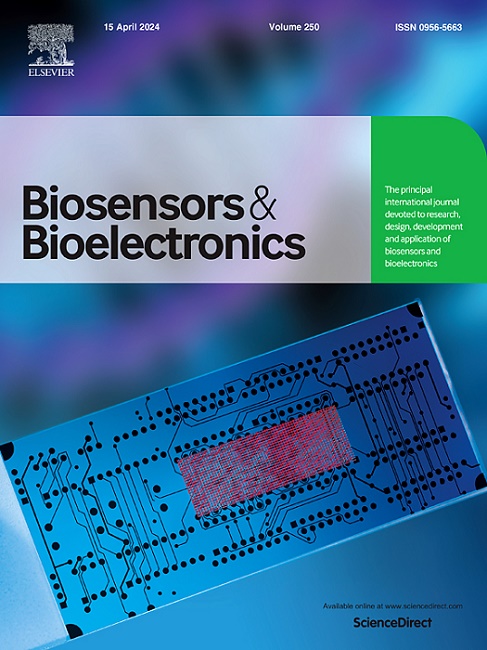基于智能手机便携设备的快速超灵敏rpa辅助CRISPR-Cas12a /Cas13a核酸诊断平台
IF 10.5
1区 生物学
Q1 BIOPHYSICS
引用次数: 0
摘要
通过及早发现传染源,及时诊断,制止传播,可以控制传染病的传播。实时荧光定量聚合酶链反应(PCR)具有较高的检测灵敏度和准确性,是目前病原体诊断的金标准。然而,由于需要专门的设备、实验室和人员,在大规模传染病暴发期间很难实现快速和即时的诊断。本文开发了一种优化的基于CRISPR的核酸检测方法,将CRISPR检测时间缩短至15 min,同时保持了较高的灵敏度。采用无核酸提取和冻干技术,可在20 min内完成SARS-CoV-2的两个靶基因、人内参基因和阴性质控样品的“样品-结果输出”检测,灵敏度为0.5 copies/μL。此外,为了便于应用,开发了一种基于智能手机的逆转录重组酶聚合酶扩增(RT-RPA)辅助crispr快速便携式核酸检测装置,集加热、离心、混合、光学检测和结果输出等功能于一体。通过智能手机进行过程控制、输出、上传检测结果。该设备不依赖于电源,并且可以在资源有限的设置中执行现场快速病毒检测。实时上传检测结果有助于快速实施疫情防控措施,为病毒性传染病的检测、控制和预防提供了创新手段。这项重要工作为管理未来可能爆发的传染病提供了一种新的有效工具。本文章由计算机程序翻译,如有差异,请以英文原文为准。
A rapid and ultrasensitive RPA-assisted CRISPR–Cas12a/Cas13a nucleic acid diagnostic platform with a smartphone-based portable device
The spread of infectious diseases can be controlled by early identification of the source of infection and timely diagnosis to stop transmission. Real-time fluorescence quantitative polymerase chain reaction (PCR) is the current gold standard for pathogen diagnosis, with high detection sensitivity and accuracy. However, due to the need for specialized equipment, laboratories, and personnel, it is difficult to achieve rapid and immediate diagnosis during large-scale infectious disease outbreaks. Herein, an optimized CRISPR-based nucleic acid detection method was developed that reduces the CRISPR detection time to 15 min while maintaining high sensitivity. By using nucleic acid extraction-free and lyophilization techniques, the ‘sample-in-result-out’ detection of the two target genes of SARS-CoV-2, the human internal reference gene, and the negative quality control sample can be completed in 20 min, with a sensitivity of 0.5 copies/μL. Additionally, to facilitate the application, a smartphone-based reverse transcription-recombinase polymerase amplification (RT-RPA)-assisted CRISPR-rapid, portable nucleic acid detection device was developed, integrating functions such as heating, centrifugation, mixing, optical detection and result output. Process control, output, and uploading of detection results were conducted through smartphones. The device is not dependent on a power supply and can perform on-site rapid virus detection in resource-limited settings. Real-time uploading of results helps to rapidly implement epidemic prevention and control measures, providing an innovative means of detection, control, and prevention of virus-based infectious diseases. This important work provides a new and effective tool to manage potential future outbreaks of infectious diseases.
求助全文
通过发布文献求助,成功后即可免费获取论文全文。
去求助
来源期刊

Biosensors and Bioelectronics
工程技术-电化学
CiteScore
20.80
自引率
7.10%
发文量
1006
审稿时长
29 days
期刊介绍:
Biosensors & Bioelectronics, along with its open access companion journal Biosensors & Bioelectronics: X, is the leading international publication in the field of biosensors and bioelectronics. It covers research, design, development, and application of biosensors, which are analytical devices incorporating biological materials with physicochemical transducers. These devices, including sensors, DNA chips, electronic noses, and lab-on-a-chip, produce digital signals proportional to specific analytes. Examples include immunosensors and enzyme-based biosensors, applied in various fields such as medicine, environmental monitoring, and food industry. The journal also focuses on molecular and supramolecular structures for enhancing device performance.
 求助内容:
求助内容: 应助结果提醒方式:
应助结果提醒方式:


